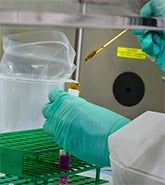The November 9 announcement from Albert Bourla, CEO of Pfizer on the efficacy of their COVID-19 vaccine candidate provided much-needed cautious optimism and momentum in the fight against COVID-19. This was then followed with an announcement from Moderna on November 16, and positive results from its own COVID-19 vaccine trial. Published interim analyses showed a vaccine efficacy of 90 percent for the COVID-19 vaccine candidate (BNT162b2) from Pfizer and their collaboration partner BioNTech at preventing SARS-CoV-2 infection and 94.5 percent efficacy for the Moderna mRNA-1273 vaccine.
This level of efficacy, if it were to hold after further trials, would far exceed the scientific community’s expectation for a first-generation COVID-19 vaccine. These trials started in the summer. For example, phase three of the Pfizer/BioNTech BNT162b2 clinical trial started just over three months ago on July 27, 2020, and is a multicenter, multinational, randomized, placebo-controlled, observer-blind, vaccine efficacy study among healthy individuals ages 12 years and older.
Both the Pfizer/BioNTech and Moderna trials evaluate two vaccine doses, with the second dose given 21 and 28 days after the first dose, respectively. The Moderna trial has 30,000 participants while the Pfizer/BioNTech trial has 43,538 participants among whom 38,955 had received the second dose by the time of interim analysis. The primary end point – the key measurement objective for the phase three trial – is to see if the vaccines prevented symptomatic COVID-19 infection evaluated at least seven days after the second dose for Pfizer/BioNTech and 14 days after the second dose for Moderna.
The vaccine candidates are still working through the phase three trial. The clinical trial protocol for phase three requires that four interim analyses (IAs) be conducted at set points, with each IA triggered after a predetermined number of COVID-19 cases has occurred among the trial participants. After these four IAs are complete, phase three culminates in one final, overall analysis.
Working closely with the U.S. Food and Drug Administration (FDA), Pfizer and BioNTech agreed that an IA2 was to be conducted only when 62 or more COVID-19 cases had occurred. By the time the Pfizer/BioNTech data was analyzed, there had been 94 cases diagnosed among trial participants, moving it past IA3. The candidates are all moving through these stages and Moderna announced on November 11 that they had accrued enough COVID-19 cases to conduct their first interim analysis (IA1).
As part of the FDA Emergency Use Authorization (EUA) for COVID-19 vaccines published in October 2020, the FDA requires a minimum efficacy of 50 percent for COVID-19 vaccine candidates. The 90 percent efficacy reported by Pfizer/BioNTech and 94.5 percent by Moderna not only meet but also far exceed the 50 percent efficacy required by the FDA. This is a breakthrough in the fight against the COVID-19 pandemic and proof that the novel mRNA technology used to develop both vaccines – a world first – can be effectively used for clinical products development.
The world is waiting in anticipation for this COVID-19 vaccine, with billions of people expected to be vaccinated once it becomes available. The exceptionally large number of people poised to receive the vaccine, most of them healthy, has made regulatory agencies extra vigilant when it comes to safety, as development has been compacted into a short-time frame. The FDA requires a median follow-up of two months after the last dose of COVID-19 vaccine before any EUA request submission. Additionally, a minimum of five severe COVID-19 cases are required in the placebo group to assess the distribution of severe cases between the two trial arms and evaluate concerns around vaccine-associated enhanced respiratory disease (ERD).
Furthermore, the EUA request is expected to include a detailed plan for active follow-up for adverse and clinically significant events such as hospitalization and deaths among vaccine recipients. Finally, in addition to phase three data, safety data from phase two and phase one trials are also required to enhance the assessment of the vaccine safety profile.
Per their joint announcement, Pfizer and BioNTech expect to meet the two-month median follow-up period and other vaccine safety requirements by the third week of November 2020. Moderna reported 11 severe COVID-19 cases, all from the placebo group. Additionally, both Pfizer/BioNTech and Moderna plan to follow vaccine recipients for 24 months after the second dose of the vaccine.
Using the RMS® COVID-19 Projection Tool (clients can click to view projections), our projections already make assumptions of COVID-19 vaccine availability starting January 1, 2021 and vaccine effectiveness ranging from 60 percent to 80 percent. This means that the Pfizer/BioNTech and Moderna announcements are in line with our assumptions for COVID-19 vaccine distribution availability starting January 1, 2021.
Transportation and storage requirements differ between the two vaccine candidates. The Pfizer/BioNTech vaccine requires deep freezing at minus 70 degrees Celsius (-94°F) for transportation and storage lasting up to ten days; it can then be thawed and stored at two to eight degrees Celsius (36° to 46°F) for up to five days. In contrast, the Moderna vaccine needs to be kept at minus 70 degrees Celsius (-94°F) and remains stable for up to six months; once thawed it can then be kept in storage at two to eight degrees Celsius (36° to 46°F) for up to 30 days. In terms of production, Pfizer/BioNTech expect a production capacity of 50 million doses in 2020 and 1.3 billion doses in 2021. Moderna announced availability of 20 million doses in 2020, and 500 million to 1 billion doses in 2021.
The reported vaccine efficacy estimates of 90 percent for Pfizer/BioNTech vaccine and 94.5 percent for Moderna are achieved under optimal clinical trial conditions, and the population-level effectiveness achieved in suboptimal real-world conditions will likely be lower than these impressive numbers. RMS projections build in real-world factors and in this context, our COVID-19 projections vaccine effectiveness assumptions of 80 percent reflect its potential real-world vaccine efficacy. How does this compare to other mass vaccines? The U.S. Center for Disease Control states that recent studies show that flu vaccination reduces the risk of flu illness by between 40 percent and 60 percent among the overall population during seasons when most circulating flu viruses are well-matched to the flu vaccine.
There are other vaccine candidates in phase three trials, and we will continue to monitor their progress and inform users of our Pandemic Projections tool about their progress. We will also follow indications of final regulatory approval, manufacturing, distribution and subsequent vaccination programs, in what will potentially be a fast-moving period. Contact sales@rms.com for more details about the RMS COVID-19 Projection Tool and RMS Infectious Diseases Model.






